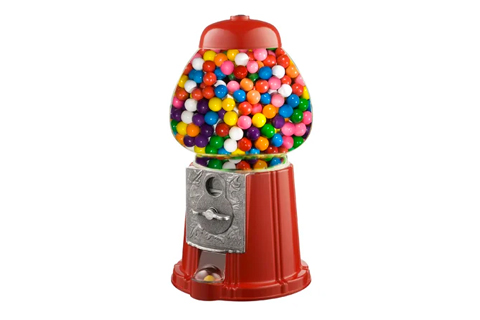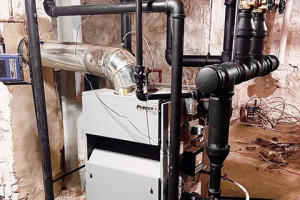
Hello, old friend. I’m writing today to say thanks, and to say farewell. This will be my last column.

My six-year-old grandboy, Brendan, was in the vestibule of the diner when the bubblegum machine caught his attention. It was one of those spiral models that appeared in the early 1990s, and a first for Brendan.
“What is this, Poppy?”
“Bubblegum.”
“What’s that?”
“Candy that you chew.”
“What is this round thing?”
“It’s a bubblegum slide. It makes the bubblegum go around and around. You catch it at the bottom.”
“Can I do it?!”
I gave him a quarter and showed him where to put it. He turned the knob and a red globe of gum started its trip around the spiral. Brendan laughed and bent to open the metal door at the bottom.
“Don’t do that yet,” I said.
“Why not?” he said as the red ball rolled across the muddy floor mat.
“That’s why not.” Brendan bent down.
“Don’t," I said. He picked up the gum and stuck it in his mouth. Oh well.
“Do I suck it or chew it?” he asked.
“Both, and in that order.”
We were walking home when he asked me to teach him how to blow a bubble, and that’s where I got stuck. Had I had my own gumball I could have shown him, but I didn’t, so there I was, trying to remember what it was like to blow bubblegum. All I had to work with were words.
“You have to flatten it with your tongue,” I said, scrunching my face around.
“How do I do that?”
“Like this,” I said, scrunching.
“I don’t get it.”
“Make the bubblegum like the shape of the quarter you put into the machine.”
“How?”
“With your tongue. Press the bubblegum against the back of your teeth.”
He made his face move like mine and then asked me what was next.
“Hold it behind your teeth and blow into it.”
He stuck two fingers in his mouth and held the gum behind his teeth.
“No, not like that.”
Then he blew the gum onto the sidewalk. He picked it up and put it back into his mouth.
I offered to get him some ice cream.
Kids have a way of dragging us old folks back in time. Brendan pushed me back about 40 years that day. He put me back on the road when I was spending most of my time teaching tradespeople about the joys of steam and hot-water heating. I was fortunate to have props in those days because when it comes to explaining things there’s not much better than a prop. Sometimes, words just won’t do. Brendan’s questions reminded me of that.
“You gotta have the pump on the return side of the boiler,” the contractor said way back when. “That’s a fact! If you don’t have it there, it can’t pull the water back from the pipes. If you put it on the supply side of the boiler, like you’re talking about, the pump can’t suck the water through the boiler because the boiler is too high. The pump’s gotta be low to suck. Everybody knows that.”
He had believed this for his entire career, and many of the other contractors in the class were nodding in agreement. “Gotta get it low so it can suck. That’s gravity. The pump needs gravity. That’s why the boiler manufacturers put the pumps down there at the bottom.”
All the words in the world couldn’t help me, so I got a photo of a Ferris wheel and I explained how a hot-water system is filled with water and under pressure, so there’s no sucking or blowing going on here.
“A hydronic pump is like the motor on a Ferris wheel,” I said. “It’s not sucking; it’s turning.”
It took years, but it finally sunk in and nowadays, most contractors know how a circulator really works. I thank props for that.
We had a small, above-ground swimming pool in those days. I took an extra filter hose with me on my seminar trips.
“This hose is like one vane on a pump’s impeller,” I said, holding up the corrugated, plastic hose. “This is the pump inlet, or what we call the eye of the impeller.” I pointed to the hole at the end of the hose. “When I spin the hose you’re going to hear a noise because the hose is corrugated and the air has to move over all those bumps inside the hose. My spinning is going to toss the air that’s inside the hose out. When that happens, more air is going to enter the hose from the opposite end because there’s going to be a difference in pressure between the two sides of the hose. Whenever there is a difference in pressure, you will get movement. It’s just like the weather. When a low-pressure area moves in, we get wind. Look at the hose. Listen to it. It’s the same thing. Can you hear the wind? Good.”
I’d swing the hose and it would make that noise. Then I’d spin it faster and the pitch would change.
“This is what happens when you change the speed of the pump,” I’d say. “Can you hear the air speed up? The same thing happens with the water in a hot-water system when you change the speed.” They’d all nod. It made sense because props make sense.
I’d place the palm of my hand over the inlet of the spinning hose and the sound would stop. “I feel a suction on the palm of my hand,” I would say. “That’s going to cause cavitation, and that’s not good.” They’d look confused. “In a hot-water system,” I continue, “cavitation happens when the pump throws out more water than it can take in. The water at the eye of the impeller drops below the pressure at which it can remain liquid. It flashes into vapor. This isn’t steam because we’re not adding heat to the water. It’s just water vapor, but when those vapor bubbles reach the outlet side of the impeller, they’re going to find high pressure again and they will collapse. The surrounding liquid water will rush in to fill the void that’s left by the collapsing vapor bubbles and that will create a water hammer that will destroy the impeller.”
Then I would show them a photo of an impeller that suffered cavitation. They’d all nod.
“If you have a swimming pool and you want to hear what cavitation sounds like, just run the filter and then stuff a rubber ball into the pool skimmer. The pump will start screaming. This actually works better if you try it on your neighbor’s pool.”
I had a non-diaphragm expansion tank in those days that had collapsed because someone had drained the system without letting air back into the top of the plain-steel tank. The tank was four feet long, 18 inches in diameter and looked like a garbage truck had run it over.
“The atmosphere did this,” I said.
My students looked doubtful, so I brought up from under the table a red bucket and a gallon jug that used to hold milk, but now held water.
“Watch,” I said, opening the jug and turning it over. As the water glugged into the red bucket the sides of the jug caved in and their eyes lit up. They had all experienced this phenomenon while preparing a milk jug for recycling, but none of them had connected it to the bad thing that could happen in a boiler room if you’re not paying attention to the air that surrounds us.
I had more props and they all helped me explain hydronics. I was able to connect things my students knew to things they didn’t fully understand. I would swing buckets of water over my head to further explain centrifugal pumps. I also held lit matches under latex balloons filled with water and smiled as my students waited for the balloon to pop, which never happened. The balloons just turned black because water is a wonderful way to move heat from here to there. And when I then held a flame under a balloon filled only with air and saw the look on their faces as the balloon popped, I told them that moving hot water is far more efficient than moving hot air when it comes to heating a building.
And the black carbon that built up on the water balloon gave me a nice segue into explaining how candles can cause ghosting above a convective radiator. It’s not the burnt fuel that’s showing up on the walls; it’s the soot from their candles.
These days, when someone has a question, such as the one Brendan asked about blowing bubbles, most folks will head to YouTube for answers. That’s helpful, sure, but if you do that often enough you’re going to find that you’re losing your ability to think for yourself. You will forget how to create analogies that help others to learn. You won’t see hydronics in a pool-filter hose. You’ll surrender your uniqueness, your creativity, your ability to explain things in a way that gets through in a way that sticks.
YouTube is always tempting us because thinking is difficult. But thinking is what makes you different. Thinking is what helps you find your own way. I could have sent Brendan to YouTube, but I stuck with him instead. I figured YouTube is a lousy grandpa.

Hello, old friend. I’m writing today to say thanks, and to say farewell. This will be my last column.

Subdural posed a question on The Wall at HeatingHelp.com in the Strictly Steam section, where some of the sharpest knives in the drawer post every day. The question was a...
I know that some wholesalers still size equipment and design systems for their contractor customers, but I wondered to what degree this still goes on nowadays. So I asked...